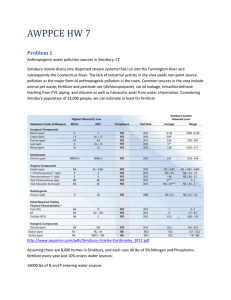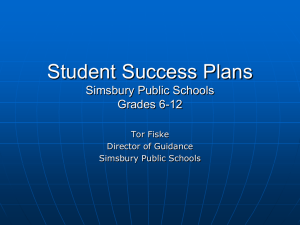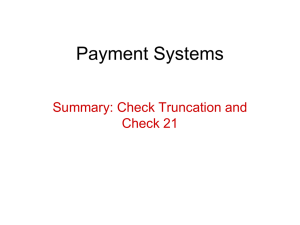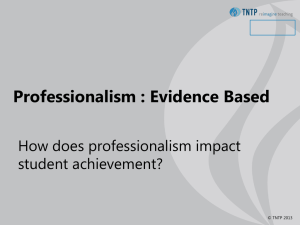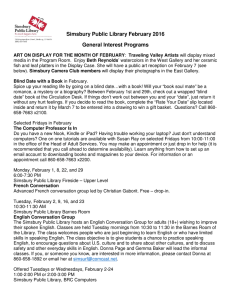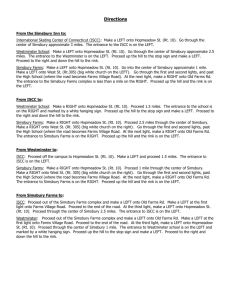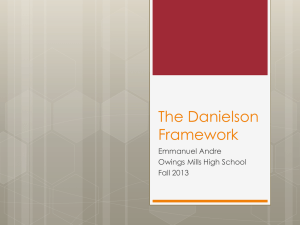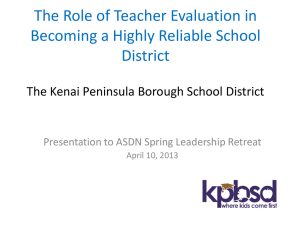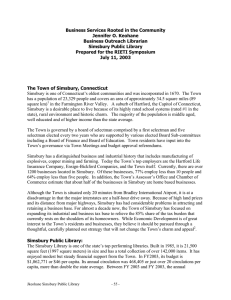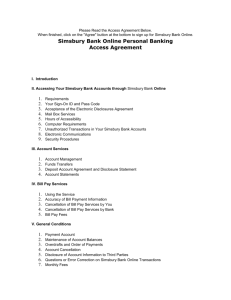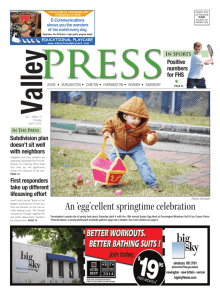Simsbury Public Schools
advertisement
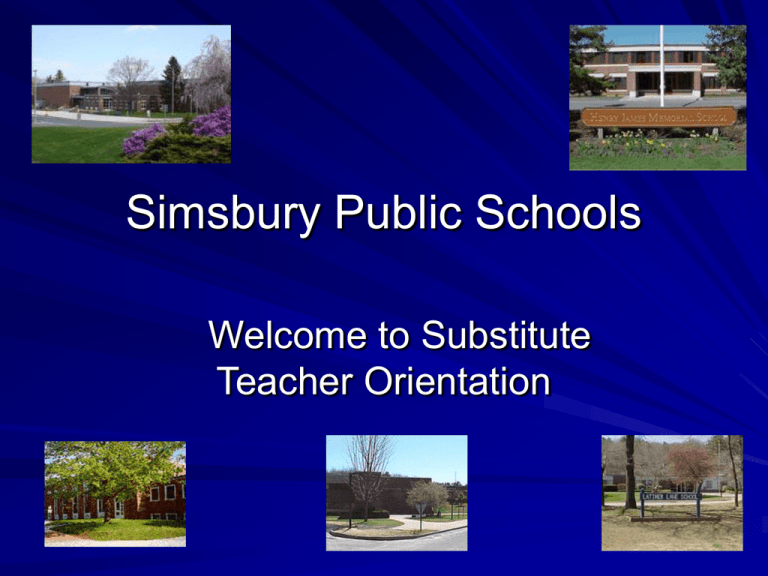
Simsbury Public Schools Welcome to Substitute Teacher Orientation On any given day . . . . Approximately 274,000 substitute teachers serve in this country’s classrooms. By the time a student graduates from high school, he or she will have spent the equivalent of a full year being taught by a substitute. Teaching Vignette Simsbury Teaching Standards Content Knowledge Teachers understand and apply essential skills, central concepts, and current instructional methodologies in their subject matter or field. Learning Environment Teachers promote student engagement, independence, and collaboration through the establishment and maintenance of a positive learning community. Planning Teachers utilize effective lesson design to plan rigorous and relevant learning tasks that enable students to construct deep meaning and to develop skills necessary for their success in a global community. Instruction Teachers implement instruction designed to engage students in rigorous learning and to develop critical skills needed to solve relevant problems. Assessment Teachers use multiple measures, inclusive of formative and summative measures, to analyze student performance and progress in order to inform subsequent planning and instruction. Professionalism Teachers maximize support for student learning by exhibiting a high level of professionalism and commitment to continuous improvement and learning. Collaboration Teachers actively engage in meaningful collaboration with colleagues on the topics of teaching and student learning. Simsbury Teaching Standard #1: 1. Content Knowledge Teachers understand and apply essential skills, central concepts, and current instructional methodologies in their subject matter or field by: a) b) c) Demonstrating discipline-specific knowledge and skills as described in national and state professional teaching standards; Using content area literacy skills to enable students to construct meaning through reading, writing, listening, speaking, viewing and presenting/creating; and Applying current research and practice in their subject matter to develop appropriate instructional methodologies. Simsbury Teaching Standard #6: 6. Professionalism Teachers maximize support for student learning by exhibiting a high level of professionalism and commitment to continuous improvement and learning by: a) b) c) d) e) Demonstrating respect and responsible behavior in all communications and interactions with stakeholders of the learning community; Reflecting regularly on their instructional practices and professional responsibilities; Seeking out and participating in learning opportunities to enhance skills related to teaching and meeting the needs of all students; Understanding the legal rights of students in order to create and/or implement individualized plans accordingly; and Demonstrating behaviors as defined in the Code of Professional Responsibility for Educators. Bullying A. Repeated use by one or more students of a written, oral, or electronic communication, such as cyber bullying, directed at or referring to another student attending school in the same school district B. A physical act or gesture by one or more students repeatedly directed at another student attending school in the same school district that: i. causes physical or emotional harm to such student or damage to such student’s property, ii. places such student in reasonable fear of harm to himself or herself, or of damage to his or her property, iii. creates a hostile environment at school for such student, iv. infringes on the rights of such student at school, v. substantially disrupts the education process or the orderly operation of a school. Professionalism Self-image and portrayal as professional to students, staff, and community Feel and act the part – they will perceive it General Rules of Conduct Rule #1: Be attentive and Present for the benefit of all students in the classroom to ensure safety o Do not give an assignment then sit to read the paper o Do not leave the classroom o Do not make personal phone calls Rule #2: Computer Use at Work o Policy o Never use the internet to surf inappropriate web sites! Rule #3: Do not gossip about classes or students o Whether you are in the teachers’ lounge or anywhere else, do not let a conversation develop into one of complaining, ridiculing, or spreading innuendoes about students or staff Rule #4: Political, Religious and Social Beliefs o By sticking to the teacher’s lesson plans, you will avoid proclaiming your opinions or attempting to convert students to your way of thinking. Be respectful of the student inquiries, but stick to the lesson at hand. Rule #5: Be friendly, positive, and enthusiastic o Firm and friendly control o Be pleasant and demonstrate an interest in their assignment o You want the students to be cooperative and hopefully deeply engaged Exercising Professional Judgment Maintain a professional barrier Keep classroom door open Do not leave your students unsupervised Use verbal praise and reinforcement Do not lose your temper NO corporal punishment Be respectful of diversity in students Use only proper humor Be confidential (what happens at school stays at school) Avoid criticizing others Classroom Management Focusing o Demand the attention of the classroom before starting the lesson o Silence on the part of the teacher can be very effective Direct Instruction o Tell the students exactly what will be happening in class today Classroom Management Monitoring o Circulate around the room Check on progress of working students Provide individual assistance as needed Quiet, calm voice Modeling o Model courteous, prompt, enthusiastic, in control, patient, and organized behavior The “do as I say, not as I do” method sends confusing messages to students Classroom Management Non-Verbal Cuing o Flip Light Switches o Facial Expressions o Body Posture o Hand Signals o Be sure to explain to the students what you want them to do when you use the nonverbal cue Classroom Management Low-Profile Intervention o Much confrontational escalation can be avoided when the teacher’s intervention is quiet and calm Do not fall for giving negative attention o Use an inconspicuous approach to misbehaving students to lessen classroom distraction o Use the students name in your dialogue in a natural way, “And you see, David, we carry the one to the tens column.” Classroom Management Use Positive Reinforcement o Notice when children are behaving and are on task and point it out o Verbal is fine – but it doesn’t have to be – a nod, smile, or a “thumbs up” will reinforce the behavior as well o Find something to compliment the students on about their work or classroom Discipline Practices Treat all students with fairness, impartiality, and responsible fairness Be alert – spot behavior problems early Students will test a sub Stress to the students that they must assume some responsibility for their actions Speak privately with students who cause problems, if possible Avoid reaching an impasse with a student Seek administrative assistance when necessary – but do not lean too heavily on this option Watch attention spans Do not leave the class unattended Adhere closely to the regular teacher’s normal routine Arrival in the Morning Arrive early – 30 minutes prior to student start time Check in at school office Always dress professionally Review the teacher lesson plans o Locate necessary teaching tools Be sure you can find the answers to: o Student Passes o Special Procedures o Duties o Students referral to office o Attendance o Restrooms/Teachers’ Lounge o Introduce yourself to the teachers on both sides of you o Review class list and plans for special needs of students Daily Student Interaction Meet students at door with confidence Write your name on board Review expectations and/or rules if posted Get students engaged right away Remind students of homework Have students straighten up their areas Be fair, positive and respectful Conclusion of Day Write a brief report about your day and leave it for the permanent teacher o Include information on student behavior, how far you got in the lesson plans, etc. Correct papers where required, neatly organize student work Close windows, turn off lights, and make sure room is in good order Check in at the office on your way out Stay approximately 15 minutes after the closing of school or until last bus leaves Paperwork Requirements Substitute Teacher Application Resume Official Undergraduate Transcripts or Certification (CT) 3 Reference Letters Proof of Fingerprinting at CREC or Simsbury Public Schools Tuberculin (TB) Test Federal and State Withholding Forms I-9 Immigration & Naturalization Form Policy Acknowledgement Forms Substitute Caller Procedure Pam Sottolano, Substitute Caller o (860) 651-3540 Communication – key to success Will call by 10:00 pm night before or after 6:00 a.m. morning of Simsbury Public Schools Thank you for Coming!
